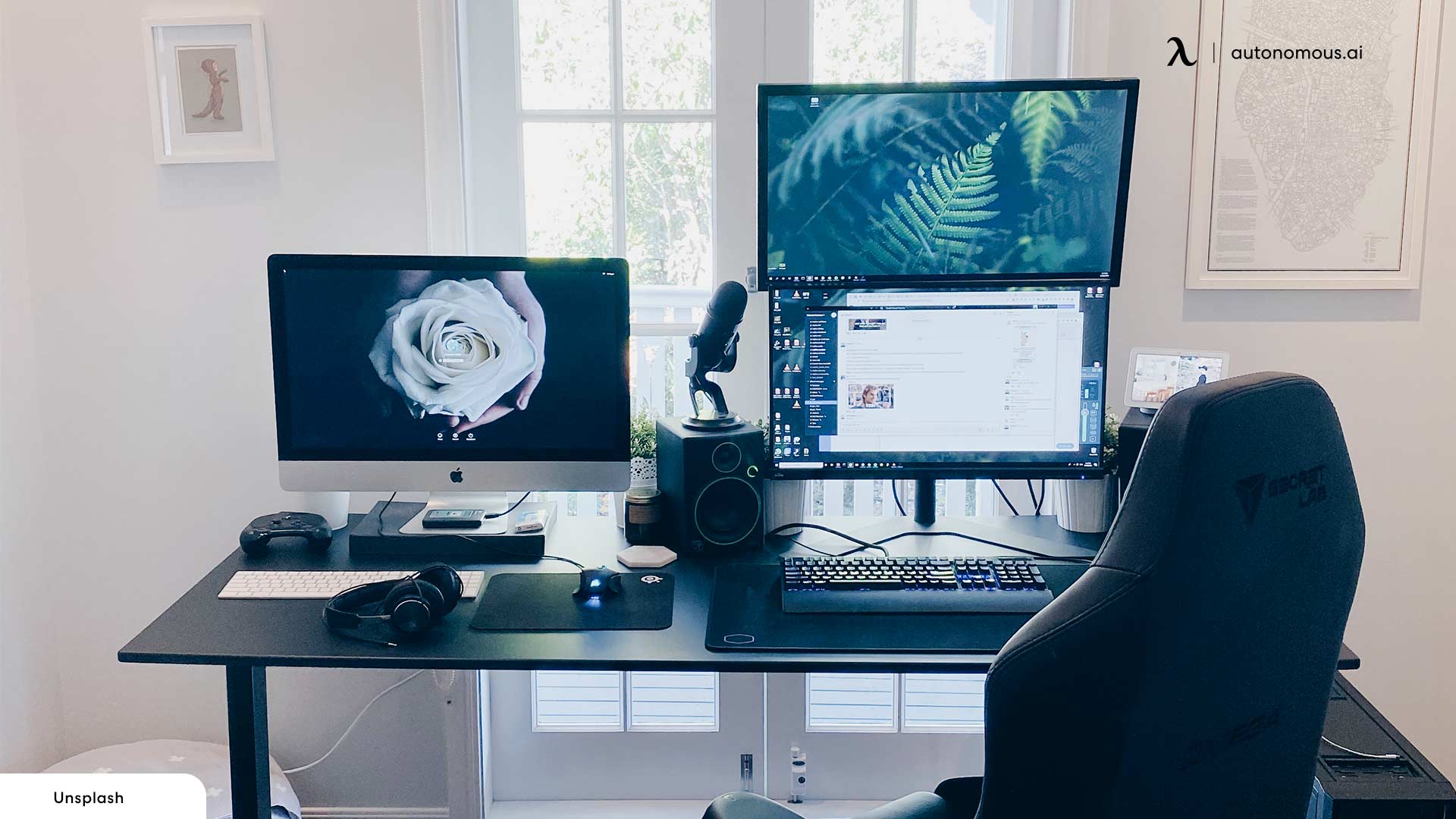
Artist Desk Setup Guideline For Ergonomic & Creative Workspaces
Table of Contents
Let’s be real—your workspace is more than just a desk. It’s where your creativity comes alive and your personal style shines.
Every artist needs the right tools and a solid canvas. However, assembling the perfect desk setup can be a daunting task, especially in a market filled with options for desks, chairs, tablets, and more. Besides, many artists who have already created one often overlook a crucial element: ergonomics.
Neglecting ergonomic principles can lead to back pain, fatigue, and creative burnout. The best artist desk setup not only boosts your art quality but also supports your body, allowing you to create longer and feel better.
Here are some inspiring ideas for artist desk setups that work in harmony with you.
Why Ergonomics Should Be At The Heart Of Every Artist Desk Setup
Digital art often demands intense focus, intricate hand movements, and long hours of seated (or hunched) work. While artists obsess over tools and canvases, many forget that your body is the most important fuel and creative tool that breathes life into every masterpiece.
Poor desk height, unsupported posture, and awkward hand angles can lead to chronic pain, wrist injuries, and even burnout. By designing your artist desk setup with ergonomics in mind, you’ll protect your most valuable asset—you.
Start With The Most Important Stage For Your Artist Desk Setup
1. An Adjustable Standing Desk
It’s crucial to make sure that you have the best work desk and chair to work on. Just in the same way a painter sets his canvas upon a sturdy and adjustable easel, a flexible standing desk and ergonomic chair can fit perfectly with your individual needs. Creativity doesn’t sit still, so why should you? A standing desk gives you the freedom to switch between sitting and standing, keeping your body energized and your mind sharp.
My pick? The standing desk from Autonomous —a design-forward option that blends beautifully into any creative studio while giving you the adjustability you need. This art desk option combines affordability with high-quality construction, power, and flexibility. Available in two spacious sizes—Classic (53” x 29”) and XL (70.5” x 30”)—and a variety of vibrant colors and finishes, it’s the perfect desk to ignite your inspiration.
Of course, for the ultimate bespoke art desk that suits your personal taste to a T and fits perfectly within your existing space, opt for the SmartDesk DIY. With the DIY Kit, you have the option of supplying your very own tabletop. The possibilities are endless! Whether it’s beautiful, thick, restored pine wood, cut, sanded, planed, and stained to perfection.
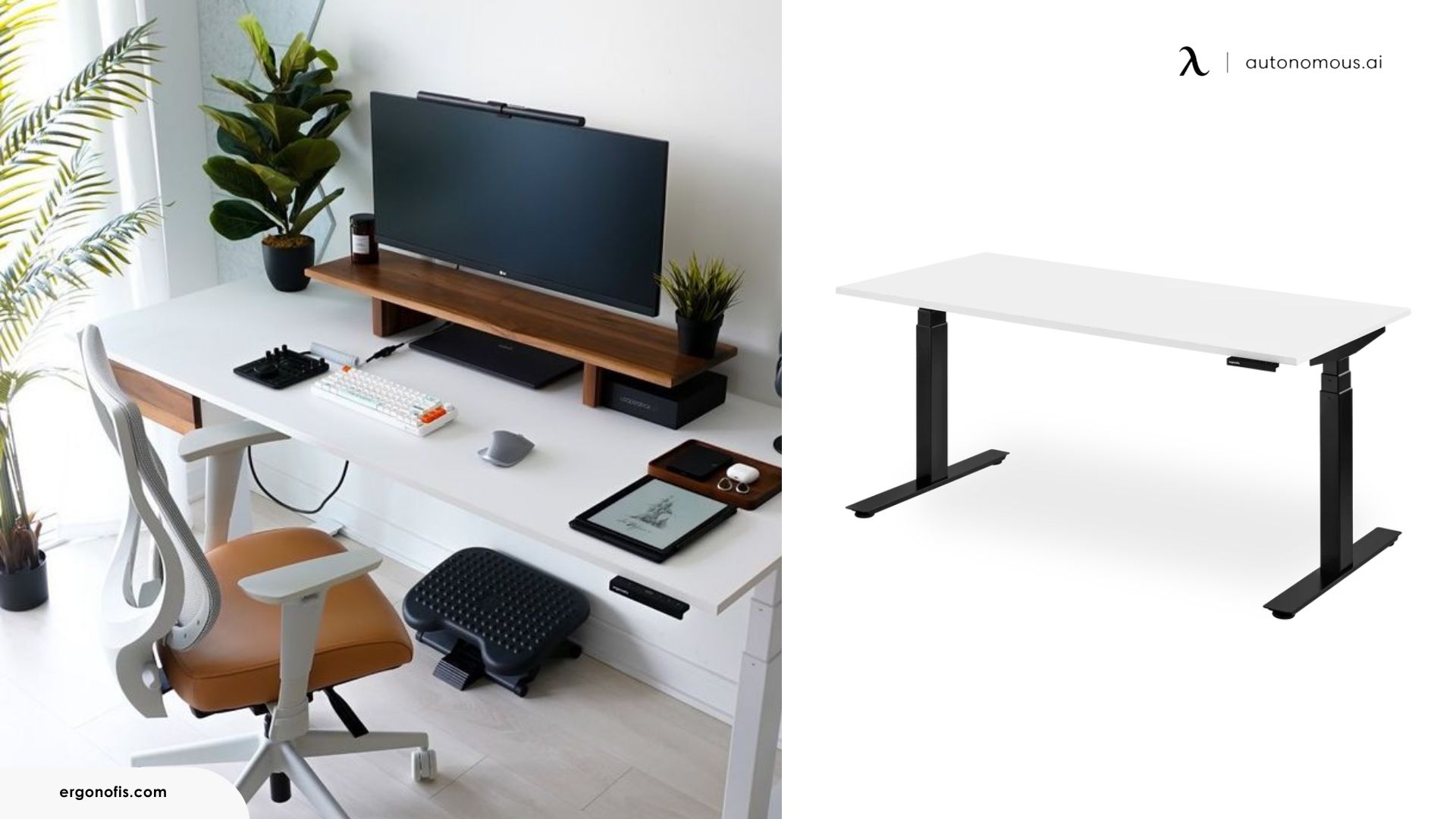
2. An Ergonomic Chair
Your chair plays a crucial role alongside your desk, especially for artists who can easily lose track of time while immersed in their work. An ergonomic chair not only supports your back but also helps alleviate neck strain, ensuring your body stays properly aligned during those lengthy creative sessions.
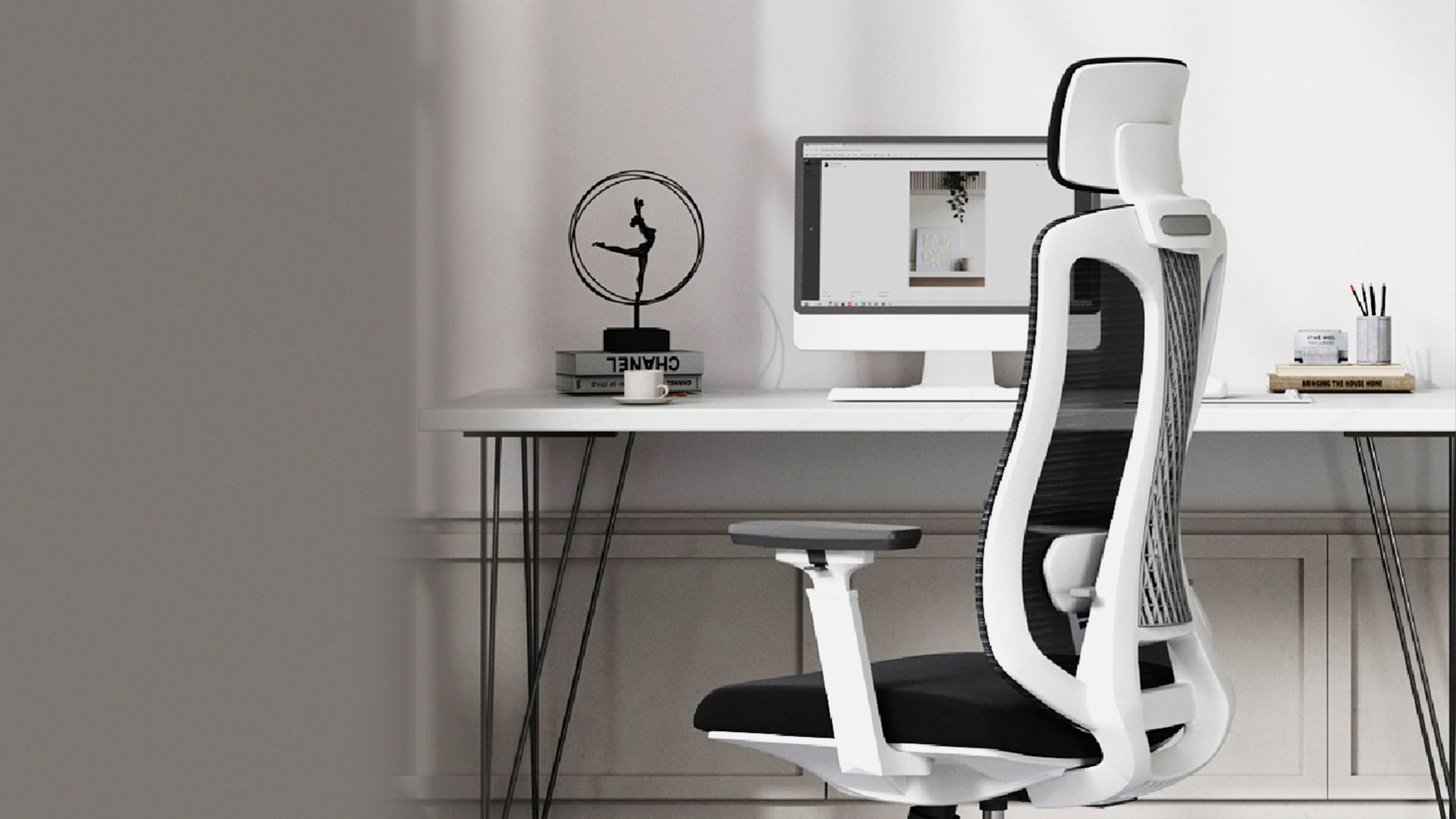
The ErgoChair 2 from Autonomous offers a fully adjustable seat tilt, height, and complete lumbar support, delivering comfort while effectively preventing aches and pains. We’ve all experienced it: when you’ve been sketching, airbrushing, or editing for hours, that nagging pain in your neck and back can kick in and suddenly bring your creative flow to a halt. Its incredibly satisfying headrest makes working on screen and editing graphics an absolute pleasure.
Check out the video below to see how an ergonomic desk setup for artists can help keep your digital life and physical wellbeing in check.
Stool
If you’re an artist who loves movement, an active stool (like a wobble stool or saddle chair) promotes micro-movements and engages your core while you work. This helps reduce static postures, keeping your body alert and energized. Perfect for: Artists who want to break free from traditional chairs and encourage more fluid, dynamic movement at their own desks. Plus point to me, it’s fun and interesting touch for your artist office setup.
.webp)
Drafting chair
For artists who use taller desks or prefer standing-height setups, a drafting chair bridges the gap between sitting and standing. With an extended height range, adjustable footrest, and ergonomic back support, it allows for upright posture without sacrificing comfort. This product is perfect for illustrators, architects, and designers who alternate between standing and seated sketching to fuel their creativity.
.webp)
3. Monitor Arm
Your monitor (or monitors) is your digital canvas—keeping it at the right height and angle is crucial. Your eyes should meet the top third of your screen to avoid neck strain. Use an adjustable monitor arm to effortlessly fine-tune your screen height, distance, and tilt. For multi-monitor setups, this ensures a seamless, strain-free view across all screens.
4. Keyboard Tray
Typing or sketching on a flat desk can force your wrists into awkward angles, leading to pain over time. An under-desk keyboard tray keeps your keyboard and stylus at the optimal height—allowing your wrists to remain straight and supported while you create. Eyeing for keyboard trays with tilt adjustment and enough space for both your keyboard and stylus pad will definitely help you level up your creating experience.
5. CPU Mount
If you’re using a tower PC, don’t forget about its position in your artist desk setup. Placing it on the floor can restrict airflow and make access tricky. A CPU mount attached under your desk keeps your PC off the floor, improving ventilation and freeing up valuable floor space—while making it easier to access ports and controls. Choose a swivel or sliding CPU mount for easy maintenance and quick cable access, keeping your creative station clean and efficient.
Tools That Support Your Workflow At Your Digital Artist Desk Setup
iPad Pro + Accessories
Of course, we can not forget about other important actual tools of a digital artist desk setup. We have been familiar with the iPad Pro and other accessories from Apple. While these products are perfect for on-the-go creators, pairing it with the Paperlike screen protector enhances your drawing comfort. The added friction reduces wrist strain and fatigue—an often-missed ergonomic win for digital artists.
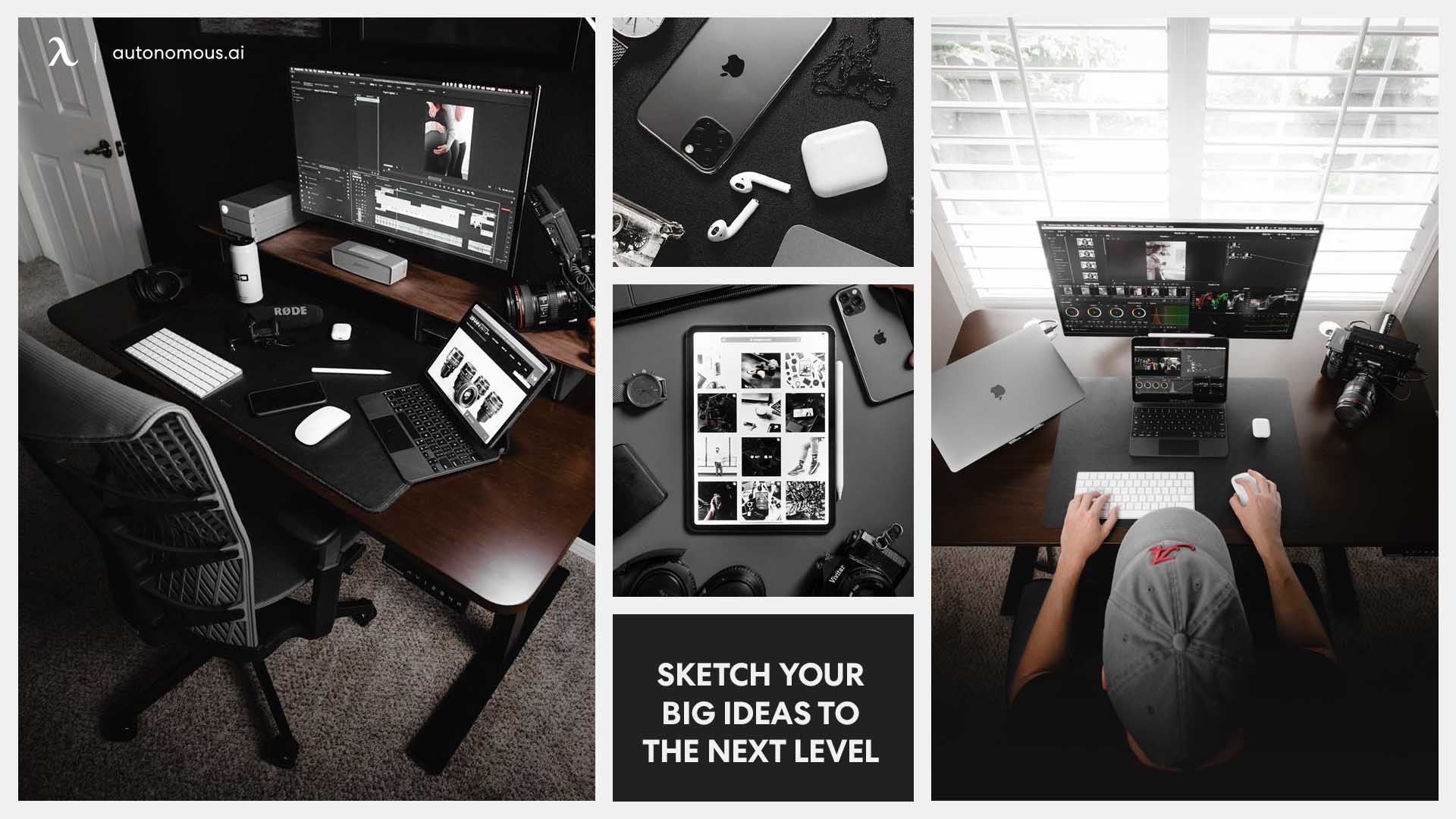
How does it work? Paperlike’s screen protector surface is engineered with Nanodots technology. The microbeads are distributed across the screen protector and make your Apple Pencil vibrate ever so slightly so it feels like you’re writing on paper. The microbeads are specifically designed so that the display light shines around and through them to minimize refractions, so as never to spoil your view. Minimizing any distracting glare and keeping your brilliant display quality.
Wacom Cintiq Pro + Ergo Stand
Another suggestion from me is the Wacom Cintiq Pro’s Ergo Stand. It totally transforms your tablet into a fully ergonomic drafting table. Tilt, rotate, and raise your display to reduce wrist extension, shoulder hunching, and awkward angles. With so much working screen space, you won’t waste time searching for that reference image or opening and closing different programs on a secondary screen. And with less need to constantly zoom and scroll in, out of, and around your work, you’ll always see the whole picture. The Cintiq Pro is by no means a mobile device, at all, but if digital art is a serious game for you it will save you valuable time and help you take control of your creativity for a more efficient controlled workspace.
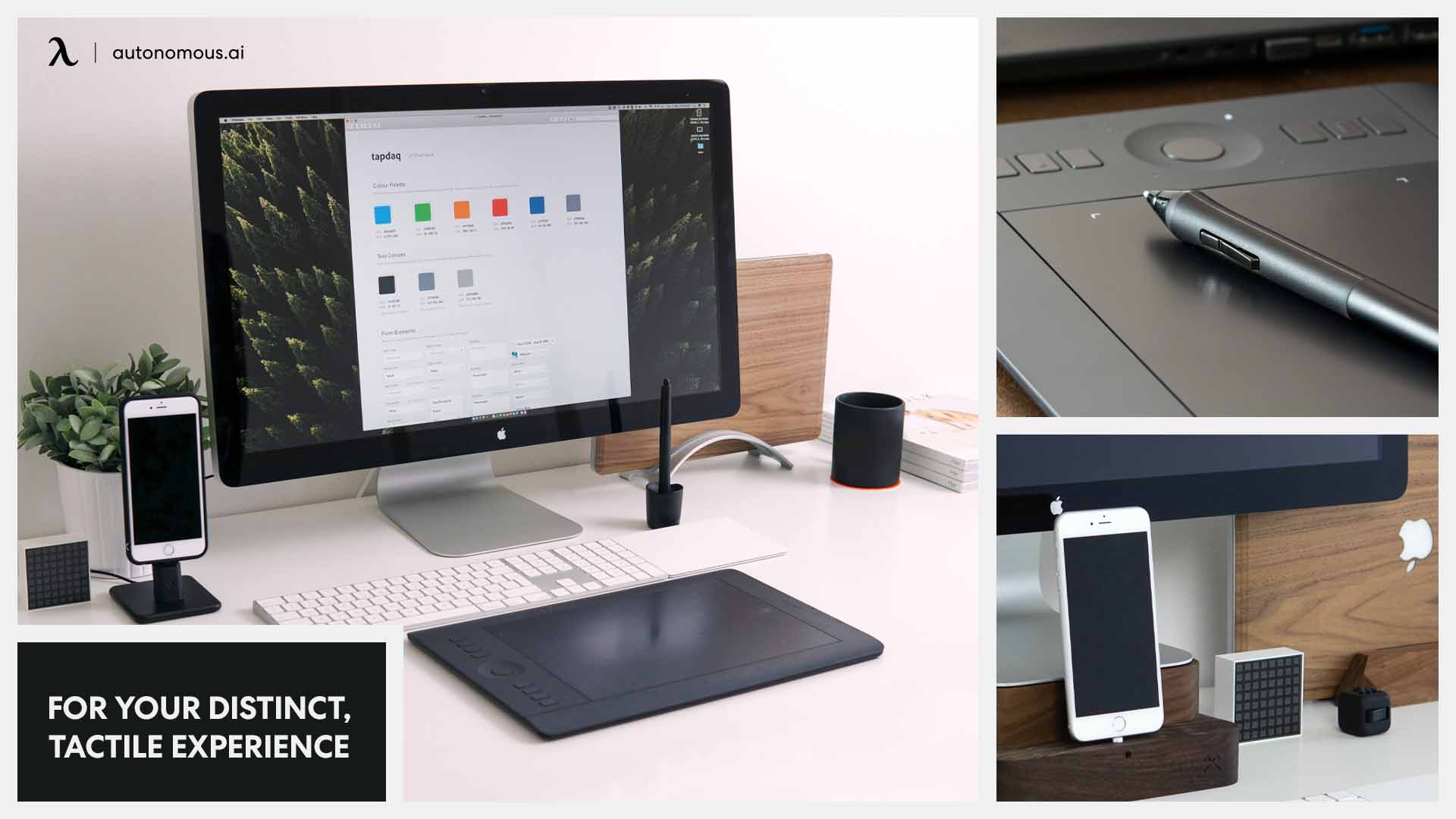
Just as Autonomous addresses the importance of ergonomic office solutions with adjustable standing desks and office chairs, Wacom also answers the call for physical wellbeing and healthy posture with the Cintiq Pro Ergo Stand. The stand allows you to raise, tilt, and rotate your Cintiq Pro display to easily adjust the viewing angle and find the most natural position for you. Once attached to the Ergo Stand, the Cintiq Pro display becomes a stable surface on which to create and feels just like drawing at a drafting table. The easily adjustable stand allows you to configure your display to suit the space and lighting wherever you happen to be working.
Accessories That Add More Spice To Your Artist Desk Setup
Awesome! Now you’ve got yourself a BOSS standing desk and ergonomic office chair to keep you physically sound during every creative hour, and the perfect stylus and tablet option to suit your illustrative needs. Here are a few more accessories and fixtures to really give you that artistic edge.
Two-Finger Glove: Comfort Meets Clean
The one unavoidable thing about touch screen displays that annoys so many tech lovers the world over. Is fingerprints. And think about it, for the most natural drawing experience, you need to comfortably rest your entire hand onto the page as you draw. The Parblo Two-Finger Glove reduces friction, keeping your hand relaxed and your drawing motions fluid while avoiding strain and smudging.
Beyond your tools, don’t forget to move. Add reminders to stretch, walk, or even dance. The Bang & Olufsen Beoplay P6 isn’t just about great sound—it’s your excuse to get up and groove, resetting both your body and mind.
Ergonomic Lighting to keep things lit
For true color accuracy, a darker working environment is beneficial. If your workspace has windows, install some simple shutter blinds or hang some thick blackout curtains to create the perfect den and view the truest colors on screen. Make sure to equip the workspace with artificial light that gives you options. LED desk lamps that offer brightness levels, as well as tonal transitions between warm and neutral, are really useful in setting up the perfect lighting conditions for when you want to switch on your screens and create your best work.
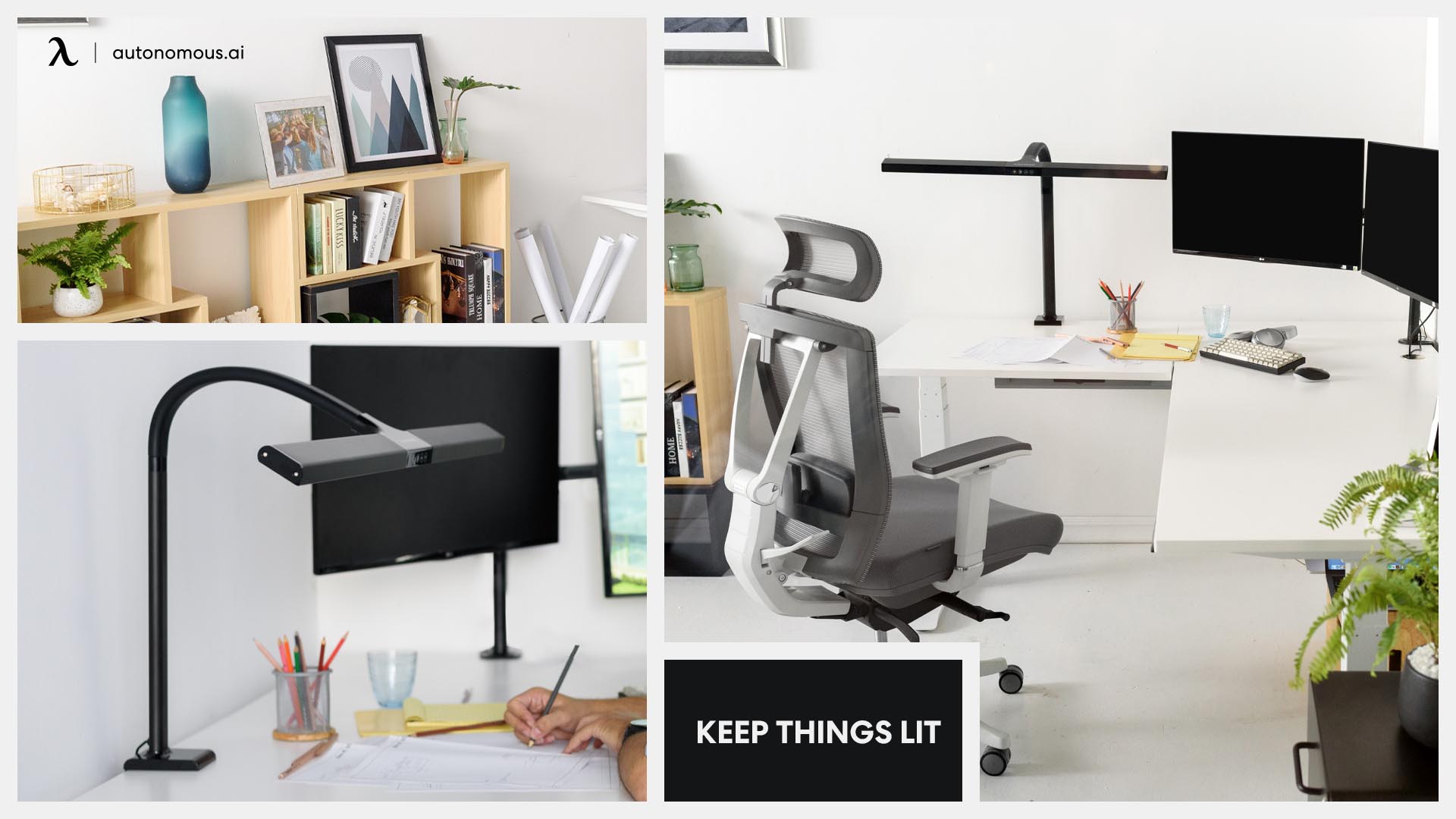
Artist Desk Setup Inspirations
Crafting the perfect artist desk setup with the touch of ergonomics doesn’t mean sacrificing style, especially home office setup. Combining both style and ergonomics in your workspace can help you boost productivity, improve posture, and even enhance the work quality. Here are some desk setup ideas at home that are easy and accessible to show you how form and function can coexist beautifully:
- The Minimalist Creator
A clean white SmartDesk, an adjustable LED lamp, a slim iPad Pro, and a statement ergonomic chair in soft gray. Add a few personal touches, like a plant or mood board, for creative vibes. The minimalist artist desk setup is also a versatile option if you only have a small cornern to setup your own digital artist desk setup.
.webp)
- The Vintage-Meets-Digital Studio
Pair the SmartDesk DIY Kit with a rustic reclaimed wood top. Match it with a leather-look ErgoChair and vintage desk accessories. Your Wacom tablet and MacBook stay front and center, with blackout curtains for controlled lighting. With vintage lovers who always wants to add more personal touches to their artist desk setup, this classic 1963 Chevy Stepside pickup will surely be an inspiring idea to bring your own preferences to your artist office setup.
.webp)
- The Colorful Maximalist
Other artist desk setup ideas that are more interesting with bold desk accessories, a colorful wrist pad, and an egonomic chair in a pop color. Showcase your favorite art on the walls, and layer textures with soft lighting and vibrant decor that sparks your mood.
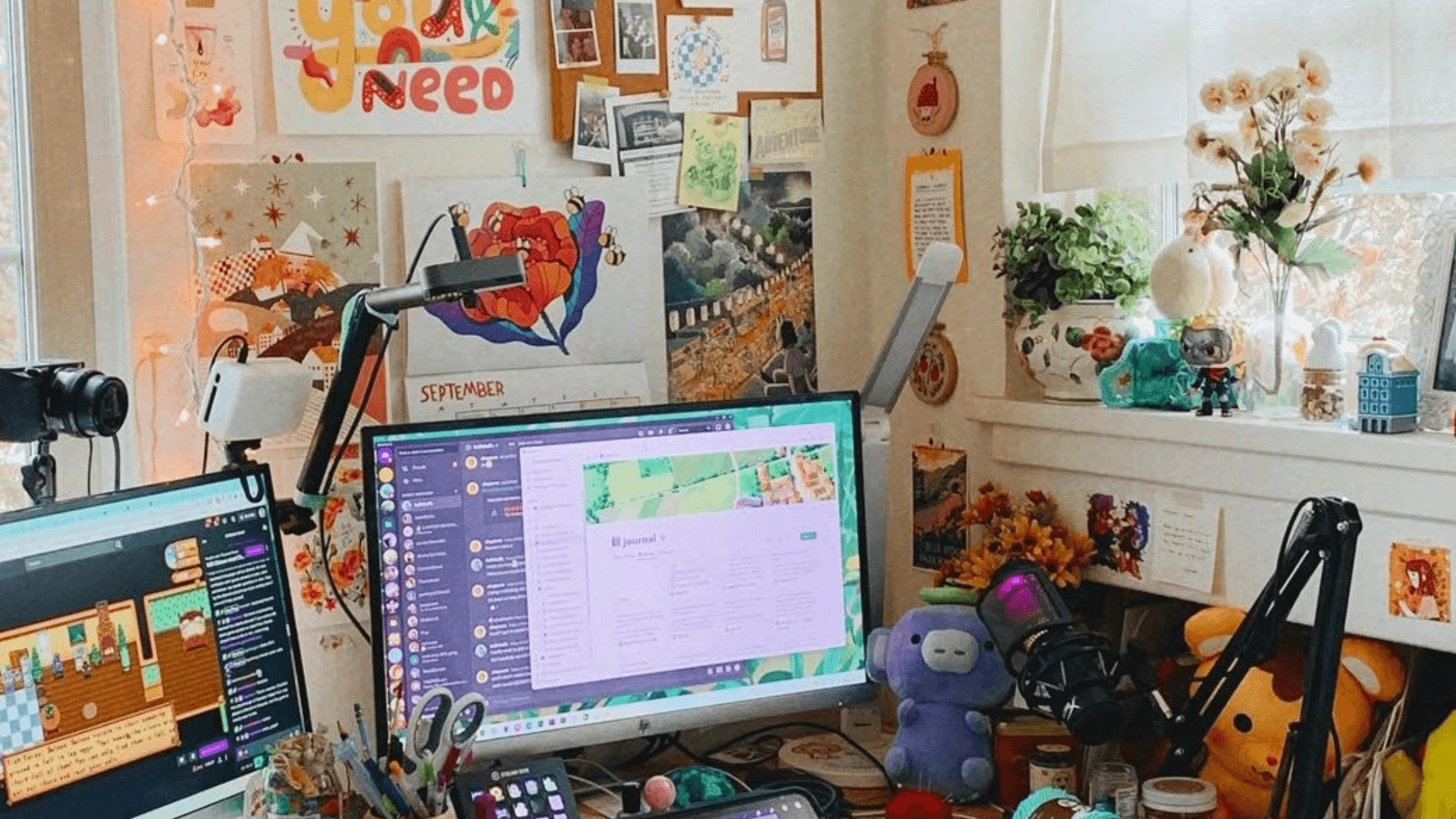
- The Vertical Monitor Setup Lover
For artists who work with long timelines, coding, or comics—vertical monitor desk setups are a space-saving, posture-friendly win.
By rotating one of your monitors vertically, you can view longer pages, code, or reference documents without constant scrolling. This is especially handy for storyboard artists, writers, comic creators, and anyone working with layered timelines in animation or video editing.
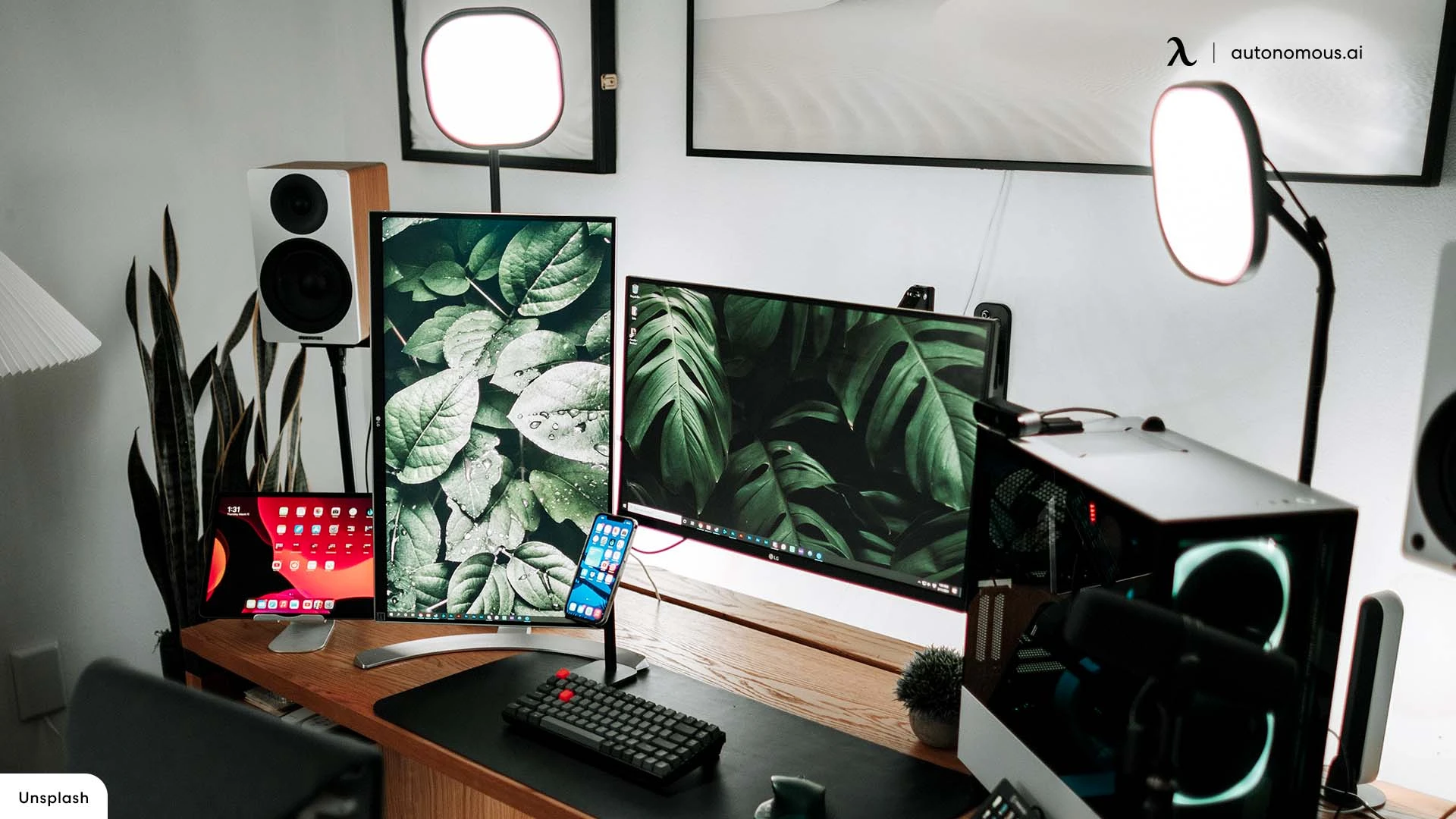
Pair your vertical monitor with an adjustable monitor arm so you can tilt and rotate as needed, ensuring your neck stays aligned and your eyes naturally meet the screen at a healthy angle.
- The 3D Artist Command Center
For artists who love a 3d artist desk setup at home may demand more changes and time-consuming tasks—larger screens, heavy-duty computers, and a need for fluid workflow across multiple devices.
A dual or triple monitor setup, paired with a CPU mount to elevate your PC off the floor, creates a clean yet powerful base. The ErgoChair 2 supports your body during long modeling and rendering sessions, while a drafting chair lets you switch up your posture during creative brainstorming. Add a stacked monitor setup for reference images and tool palettes, keeping your main screen clutter-free for 3D modeling. Combine this with a mechanical keyboard and an under-desk keyboard tray for wrist health during long keyframe editing hours.
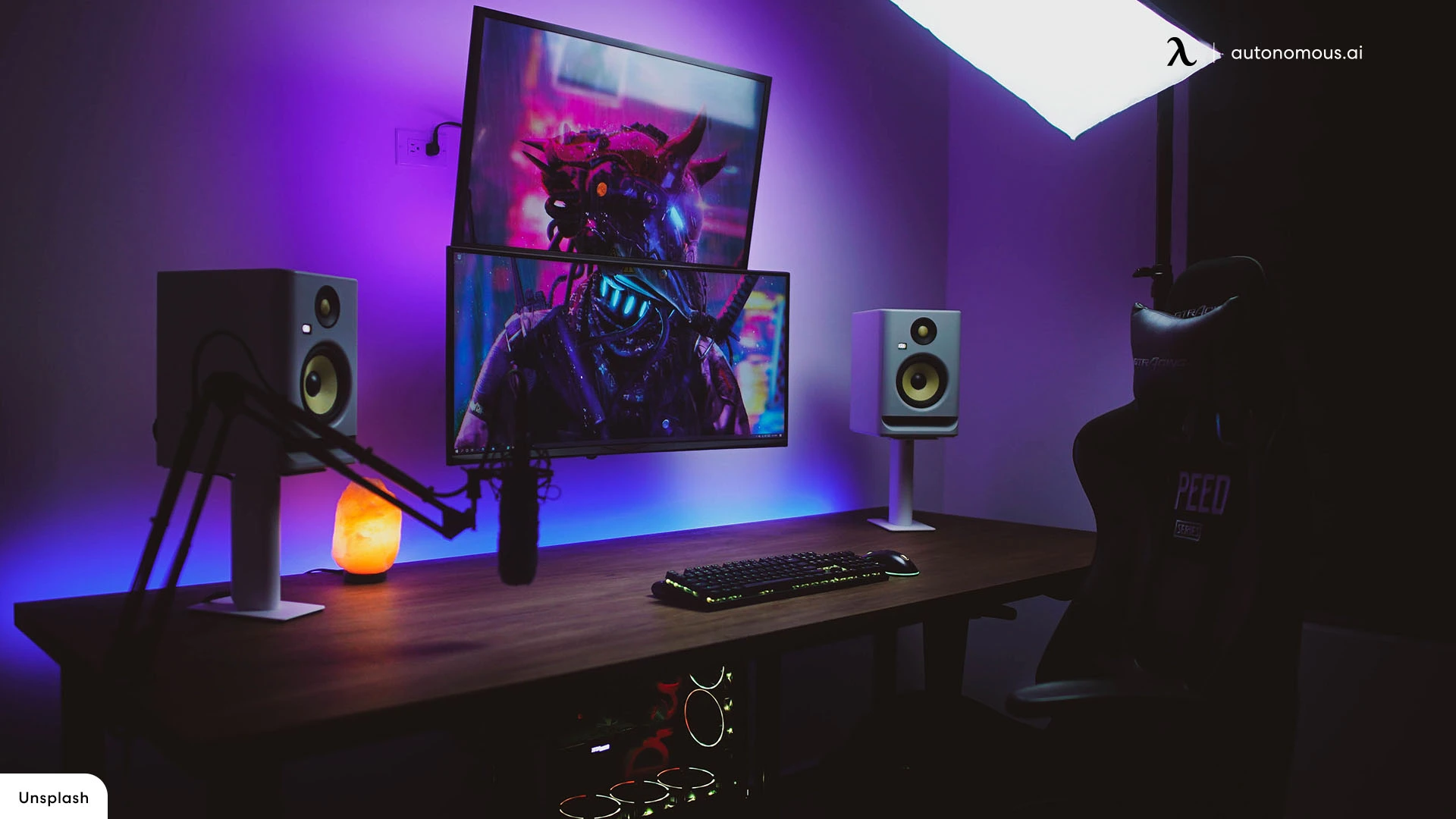
- Multi-monitor artist desk setup ideas
Expanding your digital workspace with multiple monitors can significantly boost productivity, streamline your workflow, and enhance your creative process. Here are some popular multi-monitor configurations, each tailored to different artistic needs:
Four Monitor Setup
For professionals who require extensive screen real estate, a four-monitor setup can be arranged in a 2x2 grid or a panoramic layout. This configuration is beneficial for complex projects involving multiple applications and references simultaneously.
.webp)
Dual Monitors with Laptop Integration
Combining dual monitors with a laptop offers flexibility and mobility. This setup is excellent for artists who work both in-studio and on-the-go, allowing for a consistent workflow across different environments.
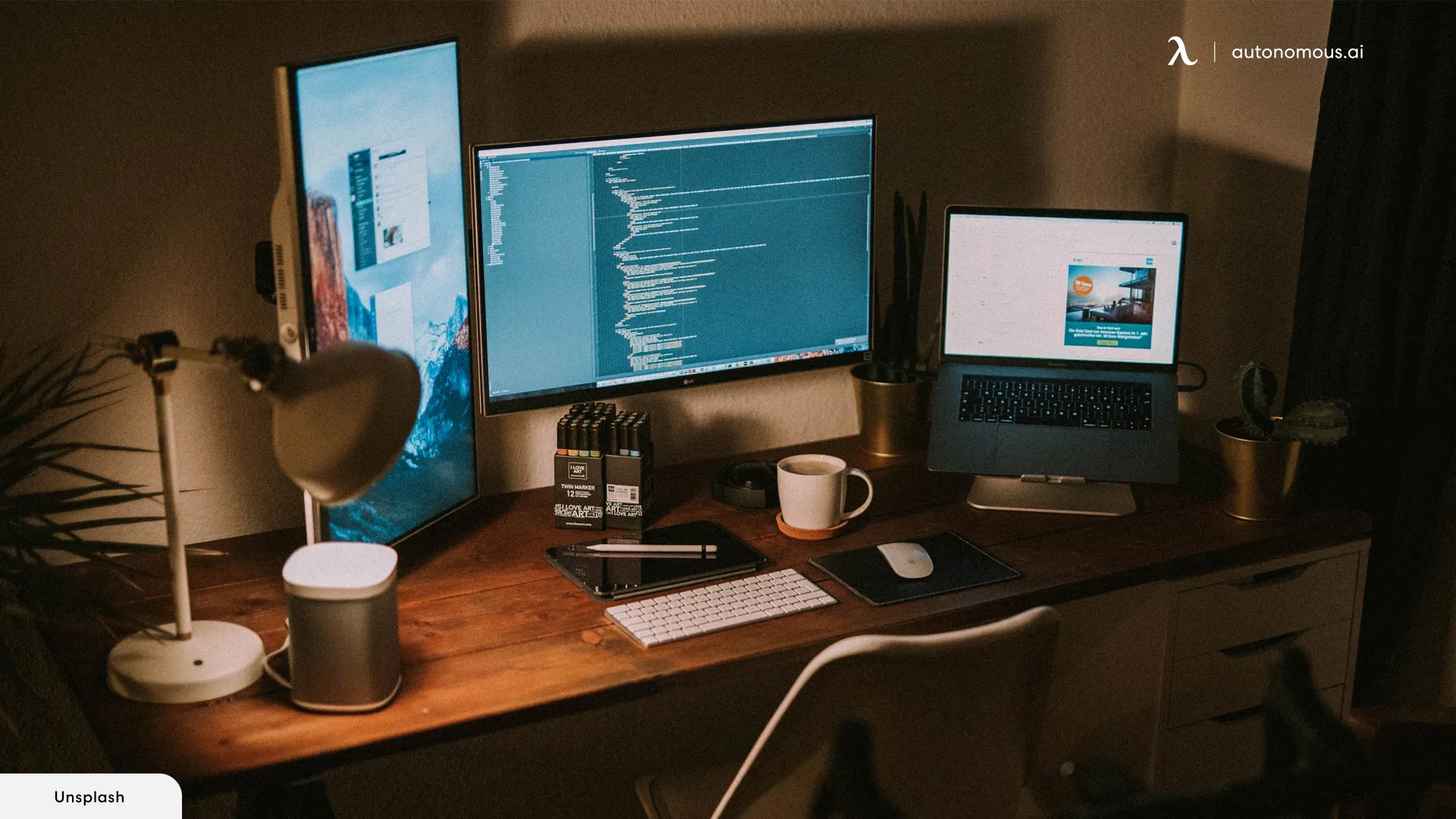
FAQs
1. How do I set up a digital art desk?
Actually, setting up a digital art desk is really easy. It only includes a desk and chair like other normal office workers. However, it is better if you invest in a standing desk and ergonomic chair to prevent back pain and make your workspace more creative.
2. Is a standing desk worth it for artists?
Definitely. Standing desks give you the freedom to move between sitting and standing—keeping your body engaged and your energy up. For artists, this means reducing creative slumps and keeping your posture in check during long sessions.
3. How do I build a small digital artist desk at home?
You don’t need much for your artist desk setup. Basically, it includes only two core components: a space and organization for your materials. So, you need only set up a desk and invest in some necessary tools for digital artists. Moreover, you’ll also need to consider your budget for this space to make it reasonable.
4. What are the essentials for a desk setup?
At the core, an artist desk setup needs a reliable desk, an ergonomic chair, a monitor or tablet at eye level, and good lighting. But for artists, it's also about adding personal touches and smart accessories—like a drawing glove, monitor arm, keyboard tray, and even a CPU mount to keep your space tidy and your workflow smooth. Think of your desk as your creative cockpit—it should support both your tools and your body.
5. How to make a minimalist desk setup?
Less is more—but only if it's functional. Start by clearing visual clutter. Invest in a clean-lined standing desk, an ergonomic chair in neutral tones, and use monitor arms to lift screens off the desk. Keep only your essential tools within reach and store the rest neatly. Add subtle decor like a plant or mood board to keep it inspiring without overwhelming the space. The key? Every item earns its place by either sparking joy or serving your work.
6. What is the ideal desk setup?
The ideal desk setup balances form, function, and body-friendly ergonomics. Your desk should allow height adjustment; your chair should support posture shifts; your screens should meet your eyes without forcing you to crane your neck. It’s about layering in tools—like monitor arms, keyboard trays, and task lighting—that make your workflow seamless while protecting your posture, wrists, and eyes. And of course, adding a dash of your personality makes it truly yours.
7. What is an ergonomic desk setup?
An ergonomic desk setup is designed to work with your body, not against it. It keeps your wrists straight, your back supported, your screens at eye level, and encourages you to move between postures throughout the day. For artists, this might mean integrating a standing desk, an adjustable chair, a monitor arm, and an under-desk keyboard tray. It’s about creating a space where your body feels good, so your creativity can flow freely without discomfort or fatigue.
Conclusion
These are all of my go-to tips for the best artist desk setup. Your artist desk setup isn’t just about aesthetics—it’s about creating a space that nurtures both your creativity and your body. From the desk and chair that support your every sketch to the monitors, trays, and accessories that make your workflow seamless, every piece should serve a purpose and support your well-being. Ergonomics isn’t an afterthought for artists. It’s the secret to creating longer, feeling better, and protecting your most valuable creative tool—your body.
Not just for digital artists who are working from home, even remote artists and parents, the artist desk setup also becomes the frontline of your work-life balance. Setting up an ergonomic, defined workspace—even in a corner of your living room—creates a mental boundary between work and home. Whether you’re sketching on an iPad, modeling in 3D, or editing on a four-monitor setup, the right environment fuels your flow, eliminates distractions, and keeps you in your creative zone. So take a step back, look at your current setup, and ask yourself: Does it support the way I want to create? Does it support me?
Because when your workspace moves with you, your art moves forward.
Stay connected with us!
Subscribe to our weekly updates to stay in the loop about our latest innovations and community news!
Interested in a Link Placement?
.svg)






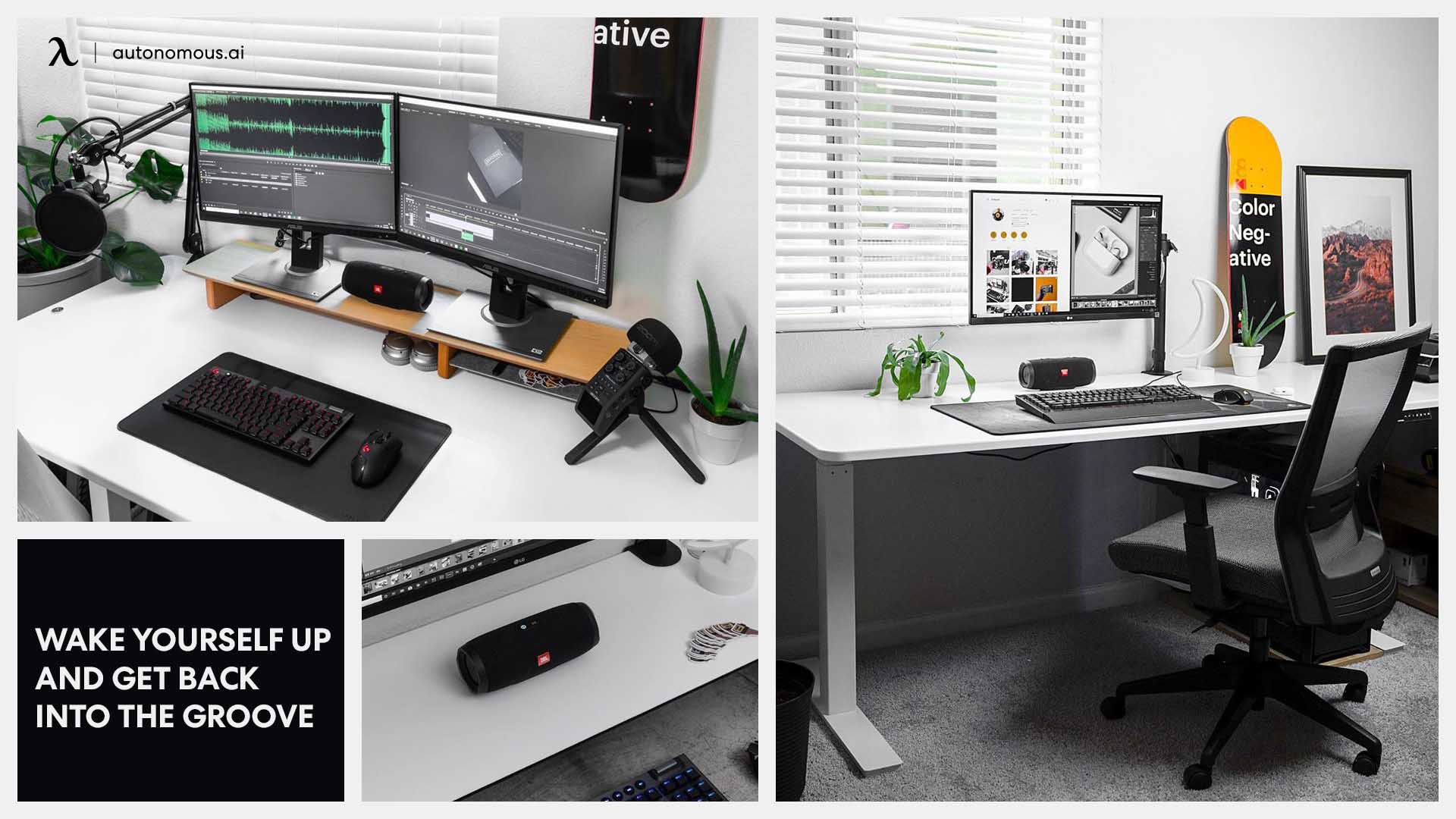
.webp)
.webp)
/https://storage.googleapis.com/s3-autonomous-upgrade-3/production/ecm/230914/bulk-order-sep-2023-720x1200-CTA-min.jpg)
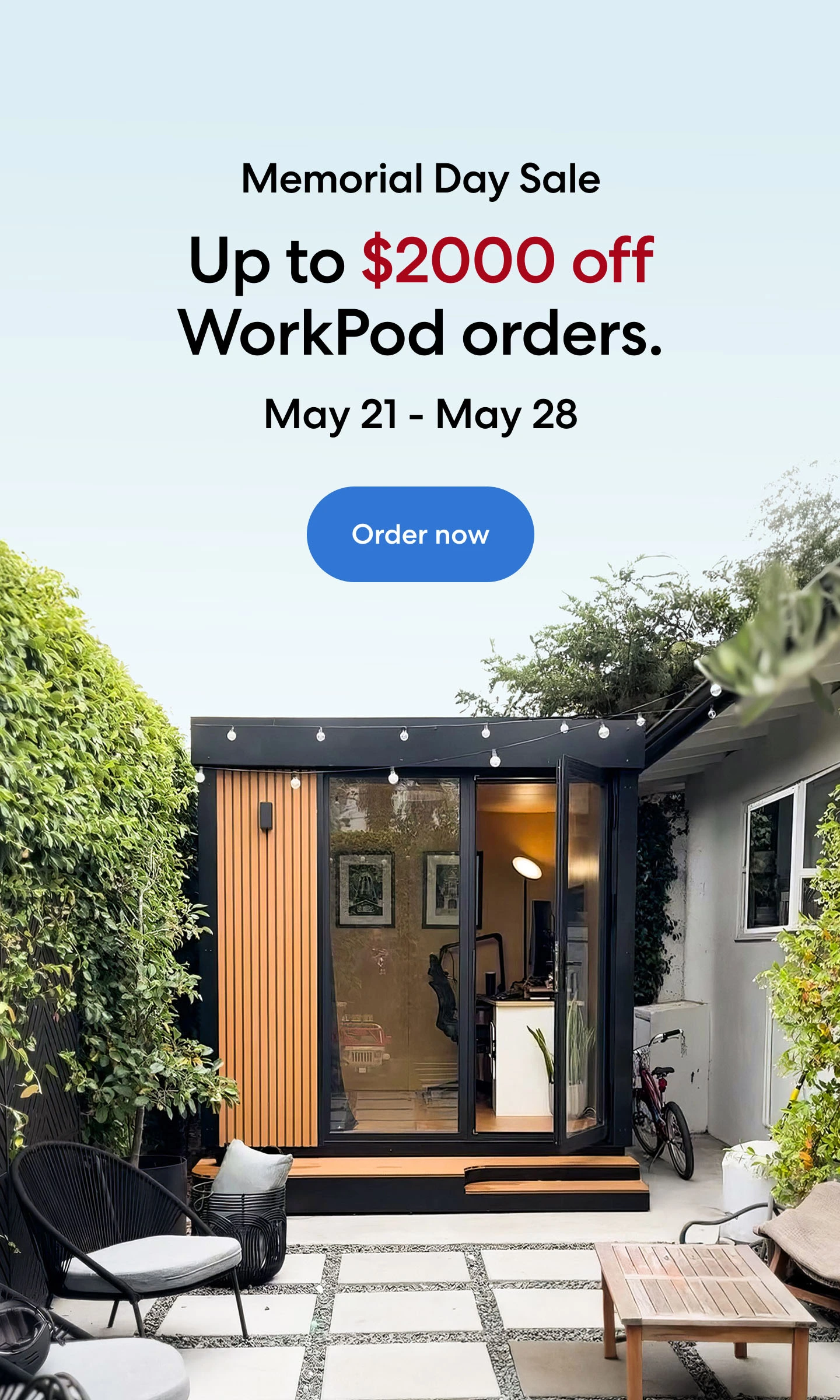
/https://storage.googleapis.com/s3-autonomous-upgrade-3/production/ecm/230824/image_hgsslSZQ_1692157696851_raw-b5b107b7-7720-45f4-b312-6e64060c14af.jpg)